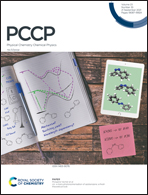From fluorogens to fluorophores by elucidation and suppression of ultrafast excited state processes of a Schiff base†
Abstract
Strategies have been explored for developing strongly fluorescent species out of a weakly fluorescent Schiff base, 2-(((pyridin-2-ylmethyl)imino)methyl)phenol (salampy). The locally excited enolic state of salampy undergoes an intramolecular proton transfer with a time constant of ca. 200 fs. The emissive cis keto state thus formed decays completely within 50 ps. Its fast decay and miniscule fluorescence quantum yield are attributed to efficient non-radiative channels associated with conformational relaxation. The anionic form, salampy−, has a significantly longer fluorescence lifetime of 800 ps. Its emissive state evolves in tens of picoseconds, from the locally excited state, by solvent and conformational relaxation. Both the neutral and anionic forms have a fluorescence lifetime of about 6 ns at 77 K, a temperature at which all activated nonradiative channels are blocked. This lifetime is similar to that obtained at room temperature, upon rigidification of the anion by complexation with Zn2+. Two such complexes have been studied. The first is binuclear, with acetate bridge between the two Zn2+ ions. The second, with ClO4− as the counterion, is mononuclear with two salampy ligands ligating the metal ion. Unlike a previous report on a different Schiff base, in which the ligands are π-stacked in its dimeric Zn2+ complex, no additional nonradiative deactivation pathway opens up in the Zn complexes of salampy, which are devoid of such stacking. The complex of salampy with Al3+ has an even longer fluorescence lifetime of 9 ns, indicating a greater degree of rigidification and consequent suppression of nonradiative processes.



 Please wait while we load your content...
Please wait while we load your content...